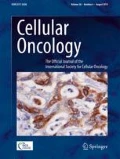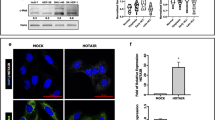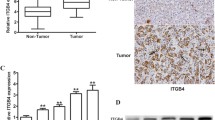Abstract
Background
Hepatocellular carcinoma (HCC) is the second leading cause of cancer-related deaths worldwide. Complete epithelial to mesenchymal transition (EMT) has long been considered as a crucial step for metastasis initiation. It has, however, become apparent that many carcinoma cells can metastasize without complete loss of epithelial traits or with incomplete gain of mesenchymal traits, i.e., partial EMT. Here, we aimed to determine the similarities and differences between complete and partial EMT through over-expression of the EMT-associated transcription factor Slug in different HCC-derived cell lines.
Methods
Slug over-expressing HCC-derived HepG2 and Huh7 cells were assessed for their EMT, chemo-resistance and stemness features using Western blotting, qRT-PCR, neutral red uptake, doxorubicin accumulation and scratch wound healing assays. We also collected conditioned media from Slug over-expressing HCC cells and analyzed its exosomal protein content for the presence of chemo-resistance and partial EMT markers using MALDI-TOF/TOF and ELISA assays, respectively.
Results
We found that Slug over-expression resulted in the induction of both complete and partial EMT in the different HCC-derived cell lines tested. Complete EMT was characterized by downregulation of E-cadherin and upregulation of ZEB2. Partial EMT was characterized by upregulation of E-cadherin and downregulation of vimentin and ZEB2. Interestingly, we found that Slug induced chemo-resistance through downregulation of the ATP binding cassette (ABC) transporter ABCB1 and upregulation of the ABC transporter ABCG2, as well as through expression of CD133, a stemness marker that exhibited a similar expression pattern in cells with either a complete or a partial EMT phenotype. In addition, we found that Slug-mediated partial EMT was associated with enhanced exosomal secretion of post-translationally modified fibronectin 1 (FN1), collagen type II alpha 1 (COL2A1) and native fibrinogen gamma chain (FGG).
Conclusions
From our data we conclude that the exosomal proteins identified may be considered as potential non-invasive biomarkers for chemo-resistance and partial EMT in HCC.









Similar content being viewed by others
References
A. Jemal, F. Bray, M.M. Center, J. Ferlay, E. Ward, D. Forman, Global cancer statistics. CA Cancer J Clin 61, 69–90 (2011)
X. Ye, R.A. Weinberg, Epithelial-Mesenchymal plasticity: A central regulator of Cancer progression. Trends Cell Biol 25, 675–686 (2015)
T.R. Samatov, A.G. Tonevitsky, U. Schumacher, Epithelial-mesenchymal transition: Focus on metastatic cascade, alternative splicing, non-coding RNAs and modulating compounds. Mol Cancer 12, 107 (2013)
S. Bugide, V.K. Gonugunta, V. Penugurti, V.L. Malisetty, R.K. Vadlamudi, B. Manavathi, HPIP promotes epithelial-mesenchymal transition and cisplatin resistance in ovarian cancer cells through PI3K/AKT pathway activation. Cell Oncol 40, 133–144 (2017)
H. Peinado, F. Marin, E. Cubillo, H.J. Stark, N. Fusenig, M.A. Nieto, A. Cano, Snail and E47 repressors of E-cadherin induce distinct invasive and angiogenic properties in vivo. J Cell Sci 117, 2827–2839 (2004)
P. Savagner, D.F. Kusewitt, E.A. Carver, F. Magnino, C. Choi, T. Gridley, L.G. Hudson, Developmental transcription factor slug is required for effective re-epithelialization by adult keratinocytes. J Cell Physiol 202, 858–866 (2005)
V. Bolos, H. Peinado, M.A. Perez-Moreno, M.F. Fraga, M. Esteller, A. Cano, The transcription factor slug represses E-cadherin expression and induces epithelial to mesenchymal transitions: A comparison with snail and E47 repressors. J Cell Sci 116, 499–511 (2003)
X.L. Zhao, B.C. Sun, D. Sun, T.J. Liu, N. Che, Q. Gu, X.Y. Dong, R. Li, Y.R. Liu, J. Li, Slug promotes hepatocellular cancer cell progression by increasing sox2 and nanog expression. Oncol Rep 33, 149–156 (2015)
Y. Sun, G.D. Song, N. Sun, J.Q. Chen, S.S. Yang, Slug overexpression induces stemness and promotes hepatocellular carcinoma cell invasion and metastasis. Oncol Lett 7, 1936–1940 (2014)
M. Zheng, Y.P. Jiang, W. Chen, K.D. Li, X. Liu, S.Y. Gao, H. Feng, S.S. Wang, J. Jiang, X.R. Ma, X. Cen, Y.J. Tang, Y. Chen, Y.F. Lin, Y.L. Tang, X.H. Liang, Snail and slug collaborate on EMT and tumor metastasis through miR-101-mediated EZH2 axis in oral tongue squamous cell carcinoma. Oncotarget 6, 6794–6810 (2015)
P. Leroy, K.E. Mostov, Slug is required for cell survival during partial epithelial-mesenchymal transition of HGF-induced tubulogenesis. Mol Biol Cell 18, 1943–1952 (2007)
J.J. Christiansen, A.K. Rajasekaran, Reassessing epithelial to mesenchymal transition as a prerequisite for carcinoma invasion and metastasis. Cancer Res 66, 8319–8326 (2006)
M. Yu, A. Bardia, B.S. Wittner, S.L. Stott, M.E. Smas, D.T. Ting, S.J. Isakoff, J.C. Ciciliano, M.N. Wells, A.M. Shah, K.F. Concannon, M.C. Donaldson, L.V. Sequist, E. Brachtel, D. Sgroi, J. Baselga, S. Ramaswamy, M. Toner, D.A. Haber, S. Maheswaran, Circulating breast tumor cells exhibit dynamic changes in epithelial and mesenchymal composition. Science 339, 580–584 (2013)
L. Lobastova, D. Kraus, A. Glassmann, D. Khan, C. Steinhauser, C. Wolff, N. Veit, J. Winter, R. Probstmeier, Collective cell migration of thyroid carcinoma cells: A beneficial ability to override unfavourable substrates. Cell Oncol 40, 63–76 (2017)
A. Lecharpentier, P. Vielh, P. Perez-Moreno, D. Planchard, J.C. Soria, F. Farace, Detection of circulating tumour cells with a hybrid (epithelial/mesenchymal) phenotype in patients with metastatic non-small cell lung cancer. Br J Cancer 105, 1338–1341 (2011)
R. Paduch, The role of lymphangiogenesis and angiogenesis in tumor metastasis. Cell Oncol 39, 397–410 (2016)
N. Aceto, A. Bardia, D.T. Miyamoto, M.C. Donaldson, B.S. Wittner, J.A. Spencer, M. Yu, A. Pely, A. Engstrom, H. Zhu, B.W. Brannigan, R. Kapur, S.L. Stott, T. Shioda, S. Ramaswamy, D.T. Ting, C.P. Lin, M. Toner, D.A. Haber, S. Maheswaran, Circulating tumor cell clusters are oligoclonal precursors of breast cancer metastasis. Cell 158, 1110–1122 (2014)
A. Grosse-Wilde, A. Fouquier d'Herouel, E. McIntosh, G. Ertaylan, A. Skupin, R.E. Kuestner, A. del Sol, K.A. Walters, S. Huang, Stemness of the hybrid epithelial/Mesenchymal state in breast Cancer and its association with poor survival. PLoS One 10, e0126522 (2015)
K.M. Danielson, S. Das, Extracellular vesicles in heart disease: Excitement for the future ? Exosomes and Microvesicles 2 (2014). https://doi.org/10.5772/58390
C. Villarroya-Beltri, F. Baixauli, C. Gutierrez-Vazquez, F. Sanchez-Madrid, M. Mittelbrunn, Sorting it out: Regulation of exosome loading. Semin Cancer Biol 28, 3–13 (2014)
D.W. Greening, S.K. Gopal, R.A. Mathias, L. Liu, J.Y. Sheng, H.J. Zhu, R.J. Simpson, Emerging roles of exosomes during epithelial-mesenchymal transition and cancer progression. Semin Cell Dev Biol 40, 60–71 (2015)
Y. Shao, Y. Shen, T. Chen, F. Xu, X. Chen, S. Zheng, The functions and clinical applications of tumor-derived exosomes. Oncotarget 7, 60736–60751 (2016)
V. Sundararajan, F.H. Sarkar, T.S. Ramasamy, The versatile role of exosomes in cancer progression: Diagnostic and therapeutic implications. Cell Oncol 41, 223–252 (2018)
M. Sponziello, F. Rosignolo, M. Celano, V. Maggisano, V. Pecce, R.F. De Rose, G.E. Lombardo, C. Durante, S. Filetti, G. Damante, D. Russo, S. Bulotta, Fibronectin-1 expression is increased in aggressive thyroid cancer and favors the migration and invasion of cancer cells. Mol Cell Endocrinol 431, 123–132 (2016)
M. Agajanian, F. Runa, J.A. Kelber, Identification of a PEAK1/ZEB1 signaling axis during TGFbeta/fibronectin-induced EMT in breast cancer. Biochem Biophys Res Commun 465, 606–612 (2015)
O. Tang, X.M. Chen, S. Shen, M. Hahn, C.A. Pollock, MiRNA-200b represses transforming growth factor-beta1-induced EMT and fibronectin expression in kidney proximal tubular cells. Am J Physiol Renal Physiol 304, F1266–F1273 (2013)
M. Kajita, K.N. McClinic, P.A. Wade, Aberrant expression of the transcription factors snail and slug alters the response to genotoxic stress. Mol Cell Biol 24, 7559–7566 (2004)
F.L. Graham, A.J. van der Eb, A new technique for the assay of infectivity of human adenovirus 5 DNA. Virology 52, 456–467 (1973)
M.W. Pfaffl, A new mathematical model for relative quantification in real-time RT-PCR. Nucleic Acids Res 29, e45 (2001)
J. Wang, Q. Wei, X. Wang, S. Tang, H. Liu, F. Zhang, M.K. Mohammed, J. Huang, D. Guo, M. Lu, F. Liu, J. Liu, C. Ma, X. Hu, R.C. Haydon, T.C. He, H.H. Luu, Transition to resistance: An unexpected role of the EMT in cancer chemoresistance. Genes Dis 3, 3–6 (2016)
G. Repetto, A. del Peso, J.L. Zurita, Neutral red uptake assay for the estimation of cell viability/cytotoxicity. Nat Protoc 3, 1125–1131 (2008)
C. Thery, S. Amigorena, G. Raposo, A. Clayton, Isolation and characterization of exosomes from cell culture supernatants and biological fluids, Curr Protoc cell biol chapter 3. Unit 3, 22 (2006)
G. Akpinar, M. Kasap, N.Z. Canturk, M. Zulfigarova, E.E. Islek, S.A. Guler, T. Simsek, Z. Canturk, Proteomics analysis of tissue samples reveals changes in mitochondrial protein levels in parathyroid hyperplasia over adenoma. Cancer Genomics Proteomics 14, 197–211 (2017)
X.F. Zheng, J.L. Carstens, J. Kim, M. Scheible, J. Kaye, H. Sugimoto, C.C. Wu, V.S. LeBleu and R. Kalluri, Epithelial-to-mesenchymal transition is dispensable for metastasis but induces chemoresistance in pancreatic cancer, Nature 527, 525–530 (2015)
N.K. Kurrey, S.P. Jalgaonkar, A.V. Joglekar, A.D. Ghanate, P.D. Chaskar, R.Y. Doiphode, S.A. Bapat, Snail and slug mediate Radioresistance and Chemoresistance by antagonizing p53-mediated apoptosis and acquiring a stem-like phenotype in ovarian Cancer cells. Stem Cells 27, 2059–2068 (2009)
Z.Y. Du, R.Y. Qin, C.F. Wei, M. Wang, C.J. Shi, R. Tian, C.H. Peng, Pancreatic Cancer cells resistant to Chemoradiotherapy rich in "stem-cell-like" tumor cells. Digest Dis Sci 56, 741–750 (2011)
L.F. Zhu, Y. Hu, C.C. Yang, X.H. Xu, T.Y. Ning, Z.L. Wang, J.H. Ye and L.K. Liu, Snail overexpression induces an epithelial to mesenchymal transition and cancer stem cell-like properties in SCC9 cells, Lab Invest 92, 744–752 (2012)
U. Manne, T. Jadhav, B.D.K. Putcha, T. Samuel, S. Soni, C. Shanmugam, E.A. Suswam, Molecular biomarkers of colorectal Cancer and Cancer disparities: Current status and perspective. Curr Colorect Canc R 12, 332–344 (2016)
H. Chang, Y. Liu, M. Xue, H. Liu, S. Du, L. Zhang, P. Wang, Synergistic action of master transcription factors controls epithelial-to-mesenchymal transition. Nucleic Acids Res 44, 2514–2527 (2016)
Y. Pan, P. Liu, D. Chen, L. Dou, Small interfering RNA (siRNA) against slug induces apoptosis and sensitizes human anaplastic thyroid carcinoma cells to doxorubicin. Cancer Biomark 18, 357–366 (2017)
K. Tsukasa, Q. Ding, M. Yoshimitsu, Y. Miyazaki, S. Matsubara, S. Takao, Slug contributes to gemcitabine resistance through epithelial-mesenchymal transition in CD133(+) pancreatic cancer cells. Hum Cell 28, 167–174 (2015)
D.P. Liang, T.Q. Huang, S.J. Li, Z.J. Chen, Knockdown of S100A4 chemosensitizes human laryngeal carcinoma cells in vitro through inhibition of slug. Eur Rev Med Pharmacol Sci 18, 3484–3490 (2014)
J. Pinkas, P. Leder, MEK1 signaling mediates transformation and metastasis of EpH4 mammary epithelial cells independent of an epithelial to mesenchymal transition. Cancer Res 62, 4781–4790 (2002)
P. Soulie, F. Carrozzino, M.S. Pepper, A.Y. Strongin, M.F. Poupon, R. Montesano, Membrane-type-1 matrix metalloproteinase confers tumorigenicity on nonmalignant epithelial cells. Oncogene 24, 1689–1697 (2005)
A. Garcia de Herreros, J. Baulida, Cooperation, amplification, and feed-back in epithelial-mesenchymal transition. Biochim Biophys Acta 1825, 223–228 (2012)
J.H. Taube, J.I. Herschkowitz, K. Komurov, A.Y. Zhou, S. Gupta, J. Yang, K. Hartwell, T.T. Onder, P.B. Gupta, K.W. Evans, B.G. Hollier, P.T. Ram, E.S. Lander, J.M. Rosen, R.A. Weinberg, S.A. Mani, Core epithelial-to-mesenchymal transition interactome gene-expression signature is associated with claudin-low and metaplastic breast cancer subtypes. P Natl Acad Sci USA 107, 15449–15454 (2010)
T.X. Dong, Y. Zhang, Y.D. Chen, P.F. Liu, T.T. An, J.W. Zhang, H.C. Yang, W.J. Zhu, X.H. Yang, FOXO1 inhibits the invasion and metastasis of hepatocellular carcinoma by reversing ZEB2-induced epithelial-mesenchymal transition. Oncotarget 8, 1703–1713 (2017)
W. Luo, X.N. Zhu, W. Liu, Y. Ren, C.H. Bei, L.Y. Qin, X.Y. Miao, F. Tang, G.F. Tang, S.K. Tan, MYC associated zinc finger protein promotes the invasion and metastasis of hepatocellular carcinoma by inducing epithelial mesenchymal transition. Oncotarget 7, 86420–86432 (2016)
Z.H. Yang, B.C. Sun, Y.L. Li, X.L. Zhao, X.M. Zhao, Q. Gu, J.D. An, X.Y. Dong, F. Liu, Y. Wang, ZEB2 promotes vasculogenic mimicry by TGF-beta 1 induced epithelial-to-mesenchymal transition in hepatocellular carcinoma. Exp Mol Pathol 98, 352–359 (2015)
J.K. Kim, H.Y. Jeon, H. Kim, The molecular mechanisms underlying the therapeutic resistance of cancer stem cells. Arch Pharm Res 38, 389–401 (2015)
N.J.-p. Martin, S. Cotteret, C. Gaudin, M. Garrido, S. Aarab-Terrisse, N. al Nakouzi, L. Gentilini, D. Compagno, V. Ogryzko, G. Meurice, K. Fizazi, A. Chauchereau, Abstract 2995: Loss of SHISA3 is an early event of the epithelial-to-mesenchymal transition associated with chemoresistance in prostate cancer. Cancer Res 75, 2995–2995 (2015)
Q. Wu, X. Wang, J. Liu, J.Y. Zheng, Y. Liu, Y.M. Li, F. Su, W.L. Ou, R. Wang, Nutlin-3 reverses the epithelial-mesenchymal transition in gemcitabine-resistant hepatocellular carcinoma cells. Oncol Rep 36, 1325–1332 (2016)
P.F. Zhang, K.S. Li, Y.h. Shen, P.T. Gao, Z.R. Dong, J.B. Cai, C. Zhang, X.Y. Huang, M.X. Tian, Z.Q. Hu, D.M. Gao, J. Fan, A.W. Ke, G.M. Shi, Galectin-1 induces hepatocellular carcinoma EMT and sorafenib resistance by activating FAK/PI3K/AKT signaling. Cell Death &Amp; Disease 7, e2201 (2016)
T.H. Chang, M.F. Tsai, K.Y. Su, S.G. Wu, C.P. Huang, S.L. Yu, Y.L. Yu, C.C. Lan, C.H. Yang, S.B. Lin, C.P. Wu, J.Y. Shih and P.C. Yang, Slug confers resistance to the epidermal growth factor receptor tyrosine kinase inhibitor, Am J Resp Crit Care 183, 1071–1079 (2011)
B. Uygur, K. Abramo, E. Leikina, C. Vary, L. Liaw, W.S. Wu, SLUG is a direct transcriptional repressor of PTEN tumor suppressor. Prostate 75, 907–916 (2015)
A.M. Haslehurst, M. Koti, M. Dharsee, P. Nuin, K. Evans, J. Geraci, T. Childs, J. Chen, J. Li, J. Weberpals, S. Davey, J. Squire, P.C. Park, H. Feilotter, EMT transcription factors snail and slug directly contribute to cisplatin resistance in ovarian cancer. BMC Cancer 12, 91 (2012)
X.-Y. Zhao, L. Li, X.-B. Wang, R.-J. Fu, Y.-P. Lv, W. Jin, C. Meng, G.-Q. Chen, L. Huang and K.-W. Zhao, Inhibition of snail family transcriptional repressor 2 (SNAI2) enhances multidrug resistance of hepatocellular carcinoma cells, PLoS One 11, e0164752 (2016)
A. Suetsugi, M. Nagaki, H. Aoki, T. Motohashi, T. Kunisada, H. Moriwaki, Characterization of CD133(+) hepatocellular carcinoma cells as cancer stem/progenitor cells. Biochem Bioph Res Co 351, 820–824 (2006)
S. Ma, K.W. Chan, L. Hu, T.K.W. Lee, J.Y.H. Wo, I.L. Ng, B.J. Zheng, X.Y. Guan, Identification and characterization of tumorigenic liver cancer stem/progenitor cells. Gastroenterology 132, 2542–2556 (2007)
W. Song, H. Li, K. Tao, R. Li, Z. Song, Q. Zhao, F. Zhang, K. Dou, Expression and clinical significance of the stem cell marker CD133 in hepatocellular carcinoma. Int J Clin Pract 62, 1212–1218 (2008)
A. Mitra, J. Yan, X. Xia, S. Zhou, J. Chen, L. Mishra, S. Li, IL6-mediated inflammatory loop reprograms normal to epithelial-mesenchymal transition+ metastatic cancer stem cells in preneoplastic liver of transforming growth factor beta-deficient beta2-spectrin+/− mice. Hepatology 65, 1222–1236 (2017)
E. Ruoslahti, Fibronectin and its receptors. Annu Rev Biochem 57, 375–413 (1988)
R. Hynes, Molecular-biology of Fibronectin. Annu Rev Cell Biol 1, 67–90 (1985)
M. Tajiri, S. Yoshida, Y. Wada, Differential analysis of site-specific glycans on plasma and cellular fibronectins: Application of a hydrophilic affinity method for glycopeptide enrichment. Glycobiology 15, 1332–1340 (2005)
S. Xia, C. Wang, E.L. Postma, Y. Yang, X. Ni, W. Zhan, Fibronectin 1 promotes migration and invasion of papillary thyroid cancer and predicts papillary thyroid cancer lymph node metastasis. Onco Targets Ther 10, 1743–1755 (2017)
J.P. Wang, A. Hielscher, Fibronectin: How its aberrant expression in tumors may improve therapeutic targeting. J Cancer 8, 674–682 (2017)
E. Sundquist, J.H. Kauppila, J. Veijola, R. Mroueh, P. Lehenkari, S. Laitinen, J. Risteli, Y. Soini, V.M. Kosma, I. Sawazaki-Calone, C.C. Macedo, R. Bloigu, R.D. Coletta, T. Salo, Tenascin-C and fibronectin expression divide early stage tongue cancer into low- and high-risk groups. Br J Cancer 116, 640–648 (2017)
N. Kanaji, N. Kita, N. Kadowaki, S. Bandoh, Fibronectin and hepatocyte growth factor produced by lung fibroblasts augment migration and invasion of malignant pleural mesothelioma cells. Anticancer Res 37, 2393–2400 (2017)
G.E. Jones, R.G. Arumugham, M.L. Tanzer, Fibronectin glycosylation modulates fibroblast adhesion and spreading. J Cell Biol 103, 1663–1670 (1986)
C.J. Clarke, T.J. Berg, J. Birch, D. Ennis, L. Mitchell, C. Cloix, A. Campbell, D. Sumpton, C. Nixon, K. Campbell, V.L. Bridgeman, P.B. Vermeulen, S. Foo, E. Kostaras, J.L. Jones, L. Haywood, E. Pulleine, H. Yin, D. Strathdee, O. Sansom, K. Blyth, I. McNeish, S. Zanivan, A.R. Reynolds, J.C. Norman, The initiator methionine tRNA drives secretion of type II collagen from stromal fibroblasts to promote tumor growth and angiogenesis. Curr Biol 26, 755–765 (2016)
T. Yoshida, M. Hashimura, T. Kuwata, T. Matsumoto, E. Suzuki, Y. Tazo, H. Nakajima, M. Inukai, M. Saegusa, Transcriptional regulation of the alpha-1 type II collagen gene by nuclear factor B/p65 and Sox9 in the chondrocytic phenotype of uterine carcinosarcomas. Hum Pathol 44, 1780–1788 (2013)
S. Muller, S. Soder, A.M. Oliveira, C.Y. Inwards, T. Aigner, Type II collagen as specific marker for mesenchymal chondrosarcomas compared to other small cell sarcomas of the skeleton. Mod Pathol 18, 1088–1094 (2005)
W.L. Zhu, B.L. Fan, D.L. Liu, W.X. Zhu, Abnormal expression of fibrinogen gamma (FGG) and plasma level of fibrinogen in patients with hepatocellular carcinoma. Anticancer Res 29, 2531–2534 (2009)
Acknowledgements
We are grateful to Prof. Dr. Mehmet ÖZTÜRK (Dokuz Eylül University, İzmir, Turkey) for generously providing Huh7 cells, to Prof. Dr. Murat KASAP (Kocaeli University, Kocaeli, Turkey) for carrying out the MALDI-TOF/TOF experiments, to Ilir SHERAJ (Middle East Technical University, Ankara, Turkey) for bioinformatics analyses and to Melis ÇOLAKOĞLU (Middle East Technical University, Ankara, Turkey) for help with the Western blots. This study was supported by the Anadolu University (1508F587) and a Türkiye Bilimsel ve Teknolojik Araştırma Kurumu (TUBİTAK) 2211-C grant.
Author information
Authors and Affiliations
Contributions
Oğuzhan Karaosmanoğlu carried out the experiments and wrote the manuscript, Sreeparna Banerjee supervised the research and wrote the manuscript, and Hülya Sivas was responsible for the overall supervision of the research.
Corresponding author
Ethics declarations
Human and animal studies
The authors did not perform experiments involving human participants or animal models in this study.
Rights and permissions
About this article
Cite this article
Karaosmanoğlu, O., Banerjee, S. & Sivas, H. Identification of biomarkers associated with partial epithelial to mesenchymal transition in the secretome of slug over-expressing hepatocellular carcinoma cells. Cell Oncol. 41, 439–453 (2018). https://doi.org/10.1007/s13402-018-0384-6
Accepted:
Published:
Issue Date:
DOI: https://doi.org/10.1007/s13402-018-0384-6




